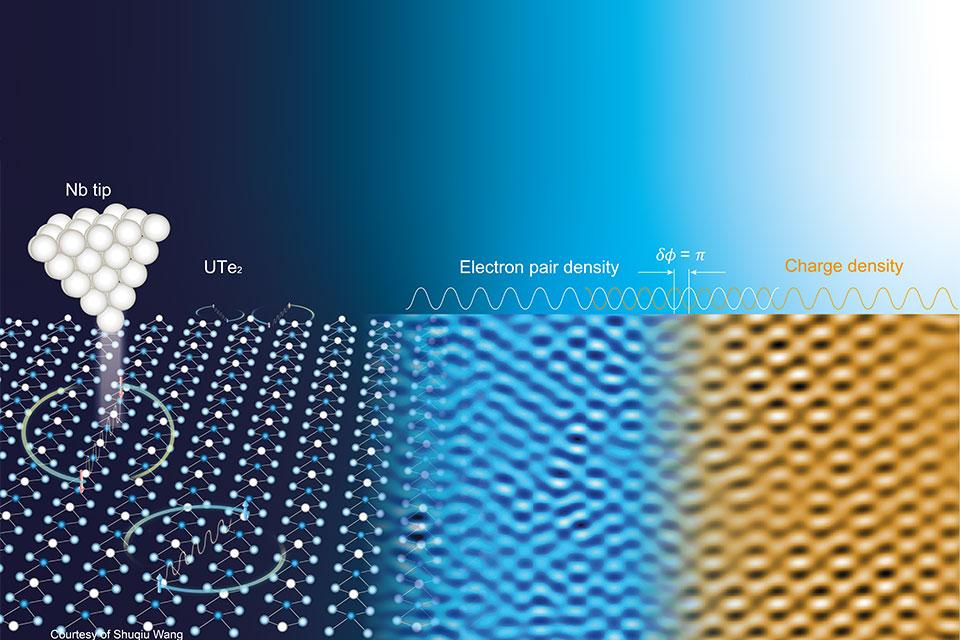Oxford scientists have revealed a new phase of matter in candidate topological superconductors that could have significant consequences for condensed matter physics and for the field of quantum computing and spintronics.
Researchers from the Macroscopic Quantum Matter Group at the University of Oxford have discovered and visualised a crystalline yet superconducting state in a new and unusual superconductor uranium ditelluride (UTe2) using one of the world’s most powerful millikelvin scanned Josephson tunnelling microscopes. This ‘spin-triplet electron-pair crystal’ is a previously unknown state of topological quantum matter.
The findings are published in the paper, ‘Detection of a pair density wave state in UTe2’ published 28 June in Nature. Cooper-pair density waves are a form of electronic quantum matter in which pairs of electrons, instead of forming a conventional ‘superconductive’ fluid where all are in the same freely moving state, freeze into a superconductive electron-pair crystal called a pair density wave state (PDW).
Lead author Dr Shuqiu Wang is a postdoctoral researcher at Oxford in Professor J C Séamus Davis’s lab; she co-led the paper with Qiangqiang Gu of Cornell University and Joe Carroll of University College Cork.
Frontiers of condensed matter physics
Superconductors are topological when the pairing potential exhibits odd-parity, leading to each electron pair adopting a spin-triplet state, with both electron spins oriented in the same direction. Topological superconductors are the target of intense research by physicists because they can, in theory, form the materials platform for ultra-stable quantum computers. However, even after a decade of intense investigation into topological superconductivity, no bulk materials, (except 3He), have been definitively recognised as spin-triplet odd-parity superconductors. Recently, the exotic new material uranium ditelluride (UTe2) has emerged as a highly promising candidate for this classification. However, its superconductive order parameter remains elusive. In 2021, theoretical physicists began to propose that UTe2 is actually in topological pair density wave state. No such form of quantum matter had ever been detected.
Pioneering technology leads to exciting discovery
In simple terms, a pair density wave (PDW) is like a stationary dance of the paired electrons found in in a superconductor, but here the pairs form periodic crystalline patterns in space. Professor Davis’ team has been focusing on this PDW state for several years, and the journey has been remarkable. The world-class scanned Josephson tunnelling microscopy conducted at millikelvin temperatures provides unparalleled microvolts scale energy resolution. For the UTe2 project the group has directly visualised the spatial modulations of the superconducting pairing potential at atomic scale and found them to modulate exactly as predicted in a PDW state.
‘What we have detected is a new quantum matter state – a topological pair density wave composed of spin-triplet Cooper pairs – and it is incredibly exciting,’ explains Dr Wang. ‘Uranium-based heavy fermion superconducting compounds are a new and exotic class of materials that provide a promising platform for realisation of topological superconductivity. Conducting the research at both Oxford and Cornell is an ideal opportunity to make use of the complementary research skills and experimental instruments at both institutions and exposes us to the research cultures in Europe and the US. This was further supplemented when I began discussing with leading experts in Europe and the US and was able to draw links between key scientific discussions in this transatlantic project. An extensive year-long study led to the exciting news that pair density waves are present in spin-triplet superconductors. Our scientific discovery pinpoints the ubiquitous nature of this intriguing quantum state in s-wave, d-wave and p-wave superconductors, and it sheds light on new avenues for identifying such states in a broad spectrum of materials.’
Detection of a pair density wave state in UTe2, Wang et al, Nature 618, 921–927 (2023).

